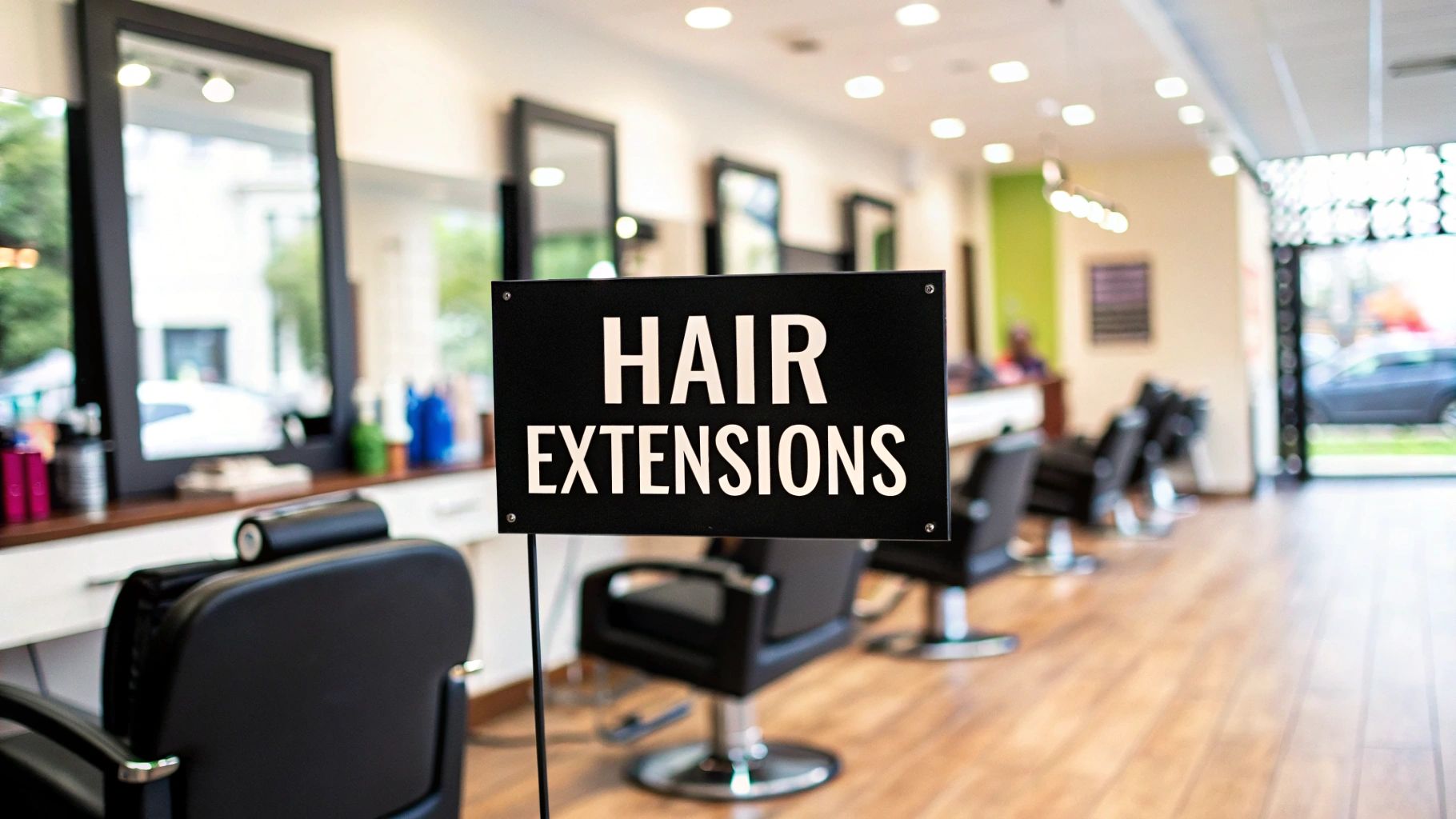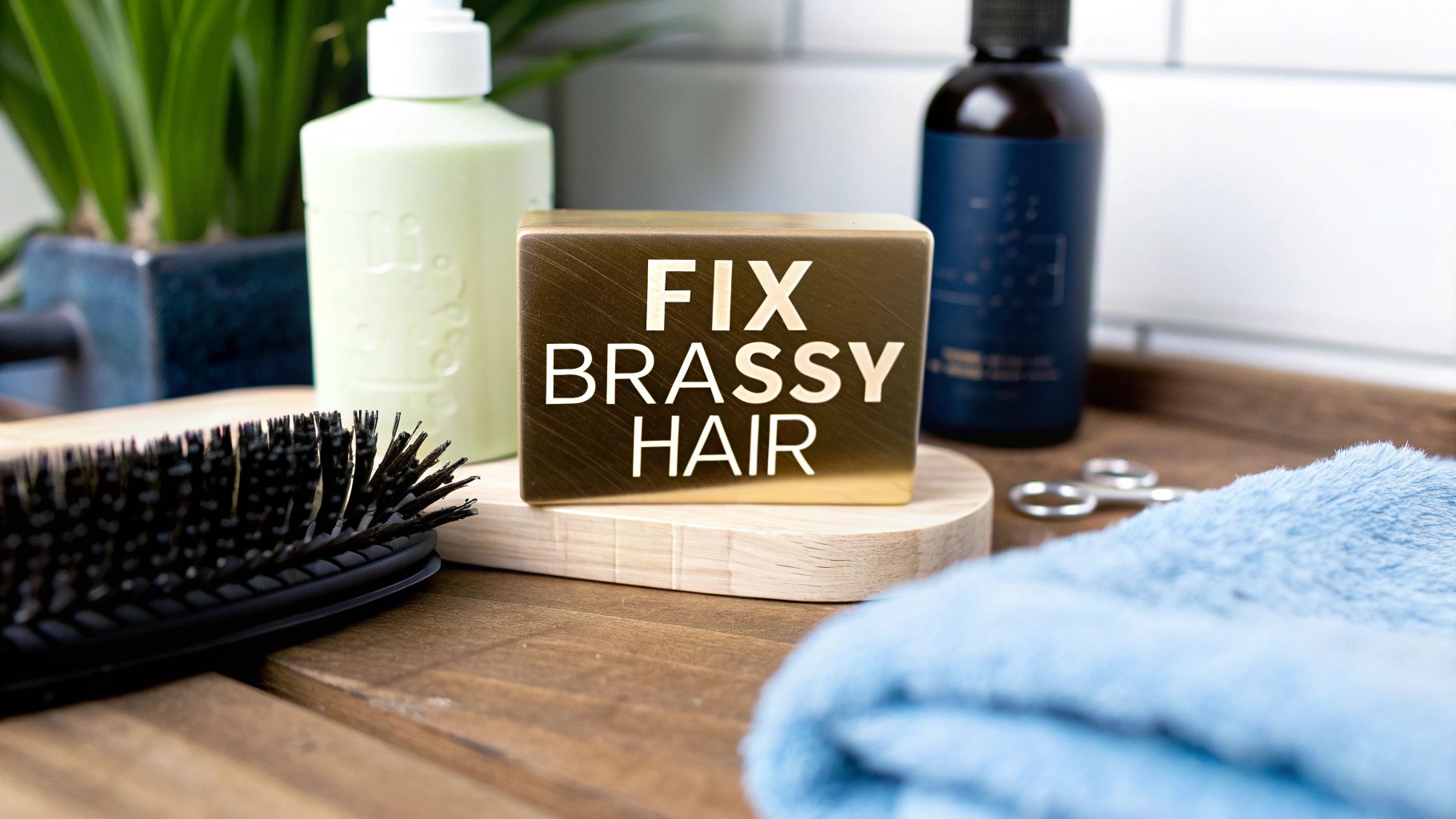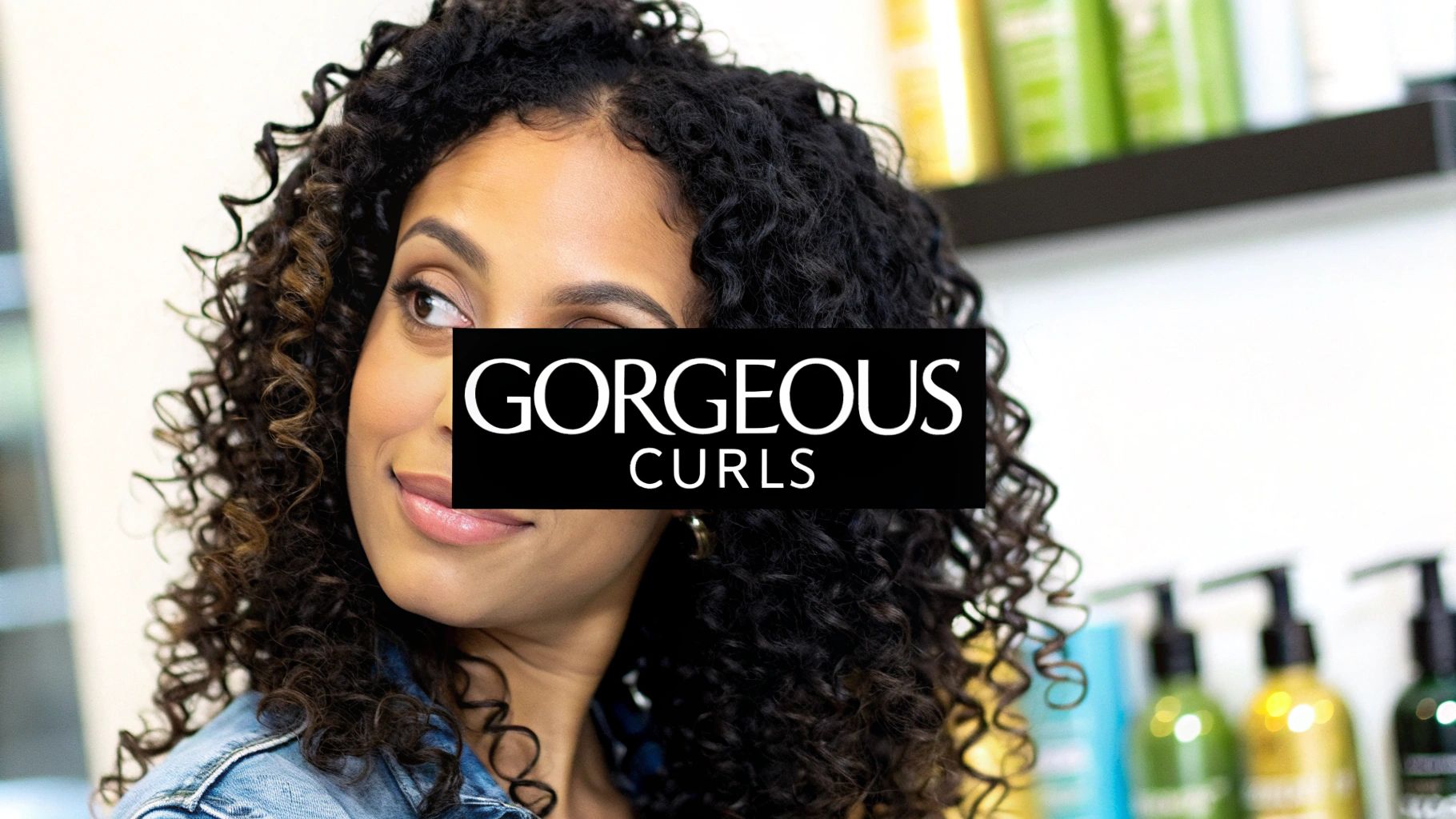So, you’ve found yourself typing "hair extension services near me" into a search bar. You’re in the right spot. Think of this as your personal guide to finally getting the hair you’ve always wanted, from figuring out what you need to finding a local expert who can make it happen.
Thank you for reading this post, don't forget to subscribe!Why Hair Extensions Are Your Secret Weapon
Let's be clear: hair extensions aren't just about adding a foot of length overnight. They're a seriously versatile tool for boosting confidence and expressing yourself. They can give you that extra oomph—volume, texture, even a splash of color—without the long-term commitment of a drastic cut or chemical process.
Extensions are the secret behind so many of the incredible hairstyles you see online and on the street. For someone with fine or thinning hair, they can bring back a sense of fullness that feels completely natural. For others, it's about pure fun—getting those mermaid waves or trying out a vibrant balayage without ever touching your own hair with bleach.
Finding the Right Professional Matters Most
Here’s the thing, though. The difference between amazing extensions and a hair disaster comes down to one person: your stylist. A truly skilled professional knows how to make extensions blend so flawlessly that no one can spot them, whether your hair is flowing down your back or pulled up in a ponytail.
More than that, a great stylist prioritizes the health of your natural hair, ensuring the application and removal process is gentle and damage-free. It's a craft that requires a sharp eye for color matching, a precise hand, and a deep understanding of hair.
Choosing the right person for the job is non-negotiable. To help you out, we put together a guide on how to find a good hair stylist that walks you through what to look for and the right questions to ask.
The goal of hair extensions isn't just to have more hair—it's to have your hair, but better. A skilled stylist makes the final result look so natural that the only thing people will notice is your newfound confidence.
This guide will break down everything you need to know, so you can feel confident making the right choice for your hair and your style.
So, What Kind of Hair Extensions Are Out There?
Walking into a salon and asking for "hair extensions" is a bit like walking into a coffee shop and just asking for "coffee." There's a whole menu of options, and the right choice for you depends entirely on your hair type, your lifestyle, and the look you're trying to achieve.
Let's cut through the jargon and talk about the most common professional methods you'll find when you search for "hair extension services near me." Think of this as your personal cheat sheet for Tape-Ins, Micro-Links, Fusion Bonds, and Sew-Ins.
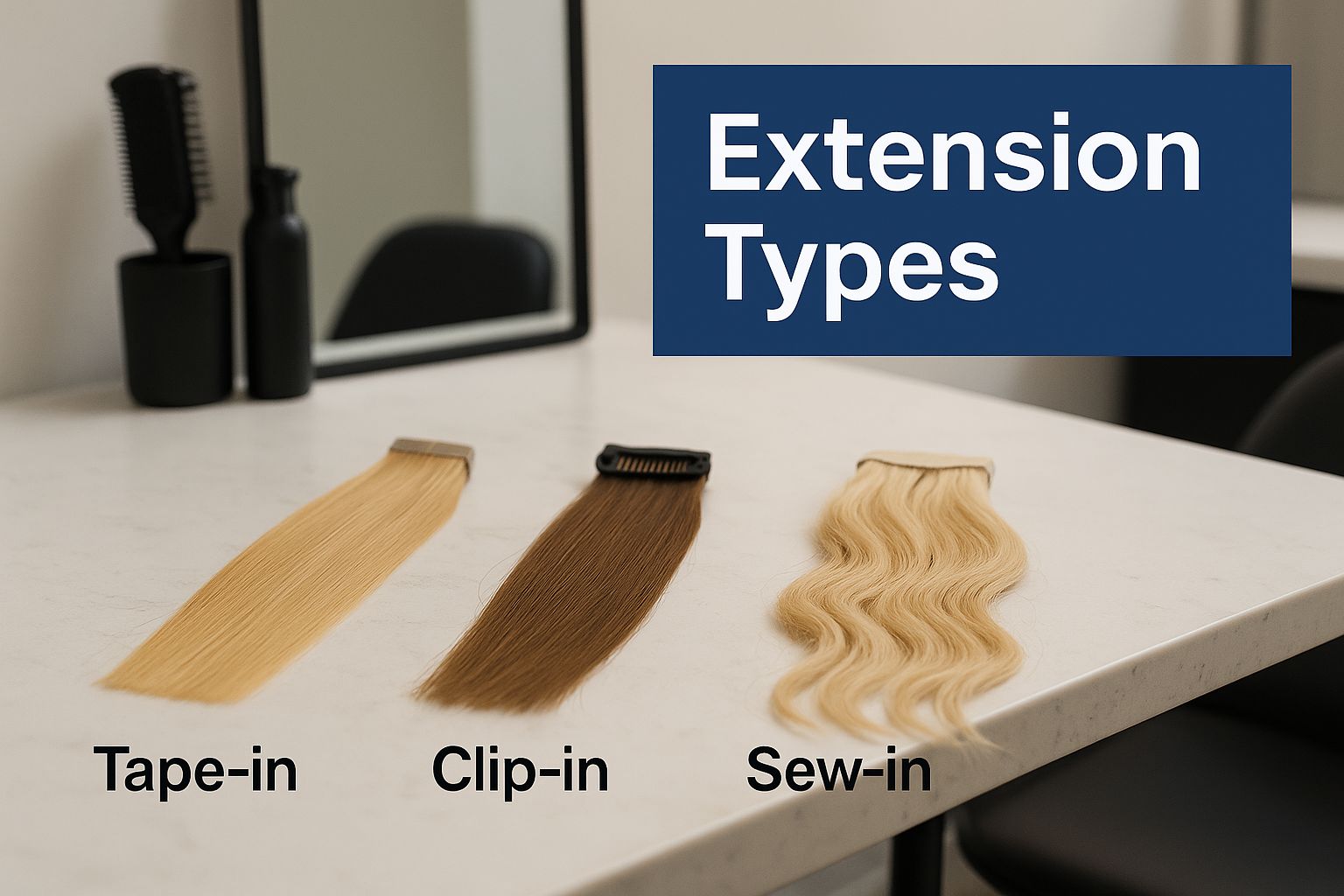
As you can see, the methods range from quick and temporary to long-lasting and intricate, each designed to create a different kind of magic.
Comparing Popular Hair Extension Methods
This quick comparison breaks down the most common professional hair extension services to help you see the key differences in application, maintenance, and cost.
| Extension Type | Application Method | Best For | Maintenance Level | Average Lifespan |
|---|---|---|---|---|
| Tape-In | Adhesive wefts are "sandwiched" around natural hair. | Fine to medium hair; adding volume and length quickly. | Medium | 6-8 weeks |
| Fusion (K-Tip) | Individual strands bonded to natural hair with keratin. | Most hair types; long-term wear and styling versatility. | High | 3-5 months |
| Micro-Link (I-Tip) | Individual strands clamped to natural hair with a small bead. | Medium to thick hair; adhesive-free, long-term wear. | High | 3-5 months |
| Sew-In (Weave) | Wefts of hair are sewn onto a braided base of natural hair. | Thick, coarse hair; protective styling and major volume. | Medium | 6-8 weeks |
Ultimately, the best method is a conversation between you and your stylist. They'll assess your hair's health and density to recommend the perfect match for your goals.
Tape-In Extensions: The Quick Transformation
Tape-ins are incredibly popular, and for good reason. The application is one of the fastest in the professional world, usually taking just 1-2 hours. They work by sandwiching a thin section of your own hair between two wefts that have a medical-grade adhesive strip.
Because they lay completely flat against the head, they're super comfortable and practically undetectable. This makes them a fantastic choice if you have fine to medium hair and want a semi-permanent boost without a huge time commitment.
Fusion and Micro-Link Extensions: The Long-Haul Commitment
If you're looking for something that truly becomes one with your hair for months at a time, you'll want to look at fusion or micro-link extensions. Both methods attach individual strands, which gives you incredible 360-degree movement and a ridiculously natural look.
-
Fusion Bonds (K-Tips): This is the gold standard for seamless, long-term wear. A stylist uses a special tool to melt a keratin bond at the tip of the extension strand, fusing it directly to your natural hair. With the right care, these can last for months.
-
Micro-Links (I-Tips): If heat and glue aren't your thing, this is your answer. This clever method uses a tiny copper bead to clamp an individual extension strand to your hair. It’s a wonderfully durable option for those who want to avoid adhesives altogether.
Be prepared for some chair time—these detailed applications can take 3-5 hours. But the payoff is a flawless blend that lasts.
Sew-In Extensions: The Classic Weave
Sew-ins, often called weaves, are a classic for a reason. This technique is perfect for anyone with thick, strong hair. Your stylist will create a neat, cornrow-like braid (or "track") close to your scalp and then carefully sew a weft of extension hair onto it.
This method is fantastic because it tucks your natural hair away, protecting it from daily styling stress. It’s the go-to for adding serious length and volume. The result is secure and can last for weeks, but getting it right is an art form. To really nail the final look, check out this guide on how to get a truly seamless blend with your extensions for some pro-level tips.
Why a Professional Application Matters
When you start looking into hair extensions, it’s easy to get tempted by those DIY kits promising a quick and cheap fix. But is skipping the salon really worth it? Honestly, no. It’s like the difference between buying a suit off the rack and having one custom-tailored. The off-the-rack version might look okay, but the one made just for you? That’s where the magic is. A certified stylist doesn’t just stick hair to your head; they’re an artist, sculpting a look that’s seamless, natural, and completely yours.
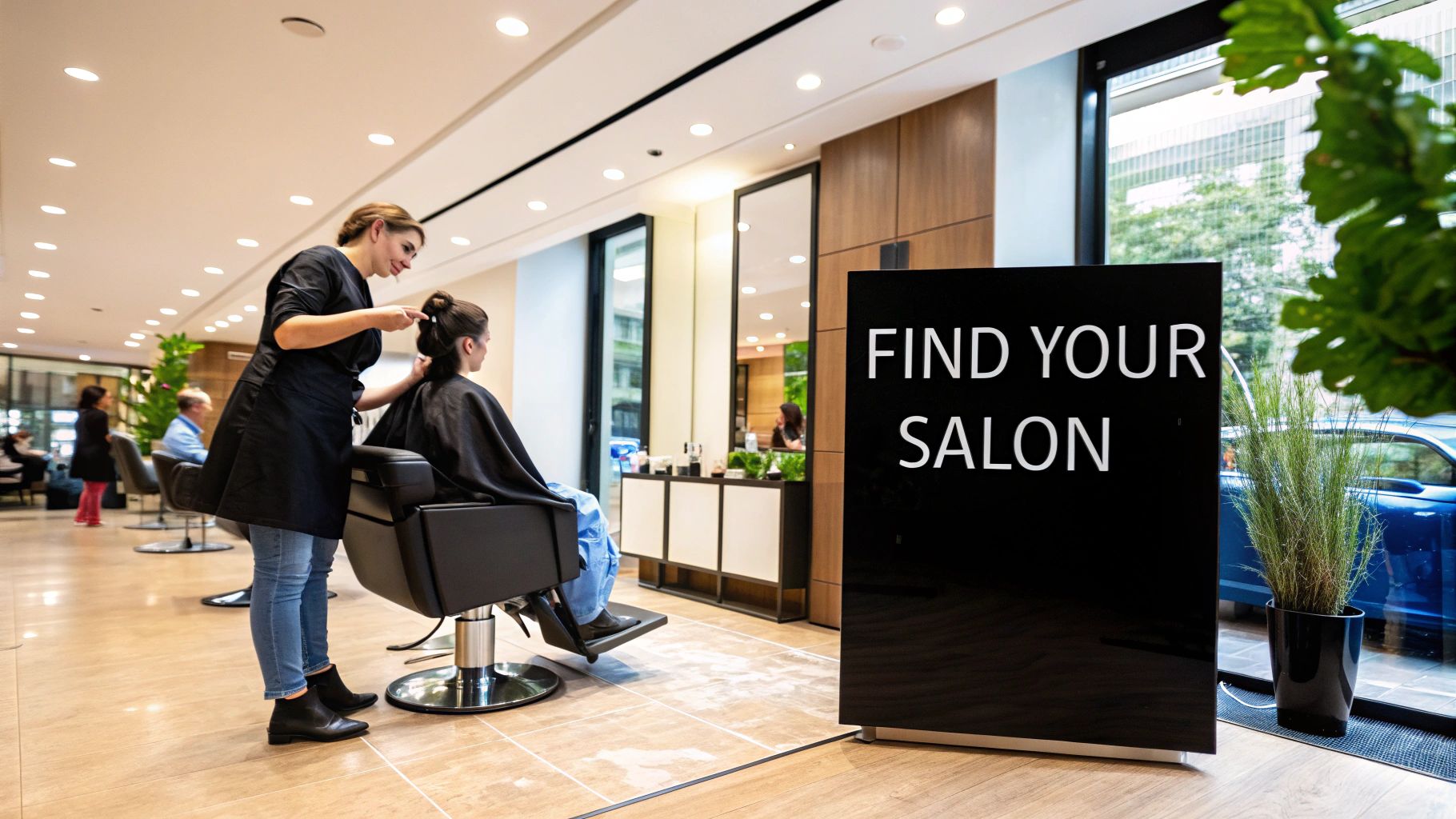
This artistry is all about the details. It starts with a perfect color match—not just close, but an exact blend that makes the extensions impossible to spot. Then comes the placement. A pro knows precisely where to put each bond or weft so it moves naturally with your own hair, blending in flawlessly whether your hair is up or down.
The True Cost of DIY Damage
Here’s the thing about doing it yourself: the biggest risk isn't just a bad look, it's actual damage to your hair. If extensions are put in too tight or in the wrong spot, they pull on your hair follicles. That constant strain can lead to serious breakage or even a type of hair loss called traction alopecia.
A professional application isn't just about how you look today; it’s an investment in the long-term health of your natural hair. The whole point is to enhance your hair, not wreck it.
An experienced stylist has been trained to distribute the weight of the extensions perfectly, so there's no undue stress on your scalp or roots. This is what makes them comfortable to wear and safe for your hair. It’s the single biggest reason why searching for professional "hair extension services near me" is non-negotiable for anyone who cares about their hair’s health.
And don’t forget, getting them out is just as critical as putting them in. A stylist has mastered the safe removal techniques for hair extensions, ensuring your hair stays healthy from start to finish.
Quality You Can See and Feel
Beyond the stylist’s skill, there's the hair itself. Salons have access to professional-grade hair that you just can't find in a box from the store. We're talking about 100% Remy human hair, which is the gold standard for a reason.
In Remy hair, all the cuticles are aligned and facing the same direction, just like your natural hair. This tiny detail makes a world of difference. It’s what prevents that frustrating tangling and matting, keeping the extensions smooth, silky, and beautiful for months. You can literally feel the quality.
The desire for this kind of premium result is bigger than ever. The global hair extension market is on track to jump from USD 2.76 billion to USD 4.43 billion because more and more people want high-quality solutions for thinning hair or simply for a new look. That growth says a lot about how much people value getting it done right.
At the end of the day, paying for a professional service isn't just about buying hair. You're investing in an expert’s skill, your own hair’s safety, and a stunning, natural look that a DIY kit just can't deliver.
How to Choose the Right Local Salon
Okay, you've done your homework on the different types of extensions. That's a huge step. But the real game-changer? Finding the right artist to bring your vision to life. A quick search for "hair extension services near me" will throw a ton of options your way, but the secret is finding a true specialist—someone who lives and breathes extensions and puts the health of your hair above all else.
You're not just looking for any hairdresser. You're looking for a certified expert. Keep an eye out for salons that are open about their credentials, showcasing certifications in specific methods like Tape-Ins or Fusion Bonds. This isn't just a piece of paper; it's proof they’ve dedicated serious time and effort to mastering their craft.
Vet Their Work and Reputation
The easiest way to tell if a stylist knows their stuff is to look at their past work. Any salon worth its salt will have a portfolio they're excited to show off.
- Scrutinize their before-and-after photos: Look closely at the pictures. Do they look professional? Is the blend completely seamless? If you can't tell where their natural hair ends and the extensions begin, you've found a winner. A great application should be undetectable.
- Dig into client reviews: Go beyond the salon's website and check reviews on multiple platforms. You're looking for recurring themes and keywords like "natural-looking," "perfect blend," or "healthy removal." Real client stories paint the most accurate picture.
- Stalk their social media: A stylist who's truly passionate about extensions will be posting their work all the time. It’s the perfect, up-to-the-minute way to see their latest creations and get a vibe for their personal style.
A stylist's portfolio is their resume. It should demonstrate not just the ability to add length, but a mastery of color matching, strategic placement, and creating a final look that enhances the client's natural beauty.
The Power of the Consultation
Here's a non-negotiable rule: never, ever commit to a salon without a consultation first. Think of it as a first date. It’s your chance to feel them out, ask questions, and make sure you click. This is also where the real planning happens, as they analyze your hair, listen to your goals, and map out a completely custom plan.
A great stylist will be an open book during your consultation. They should give you a clear, itemized quote, so there are absolutely no hidden fees or surprises down the road. This is your moment to build that all-important trust and feel confident that you’re in the hands of a pro.
Finally, show up with a list of questions. Don't be timid! A true expert will be happy to answer everything and will appreciate that you’ve done your research.
Essential Questions to Ask Your Stylist:
- Based on my hair type and lifestyle, which extension method do you think is best for me and why?
- Can you tell me where you source your hair? Is it 100% Remy human hair?
- What will my daily maintenance and long-term aftercare look like?
- How does the removal process work, and will it be safe for my natural hair?
- What's the total investment? Please break down the cost of the hair, the application, and any future maintenance appointments.
With this knowledge in hand, you’re ready to confidently pick the perfect local salon to start your hair extension journey.
Protecting Your Investment with Proper Aftercare
So, you've left the salon with the long, luscious hair of your dreams. That feeling is incredible, right? But here's the secret every seasoned extension wearer knows: the stylist's work is just the first step. Keeping those extensions looking flawless for weeks and months to come is all on you and your daily routine.
Think of it like a beautiful designer handbag—you wouldn't just toss it around. You'd care for it. Your hair extensions are no different; proper maintenance is absolutely essential to protect their quality and get the most out of your investment.
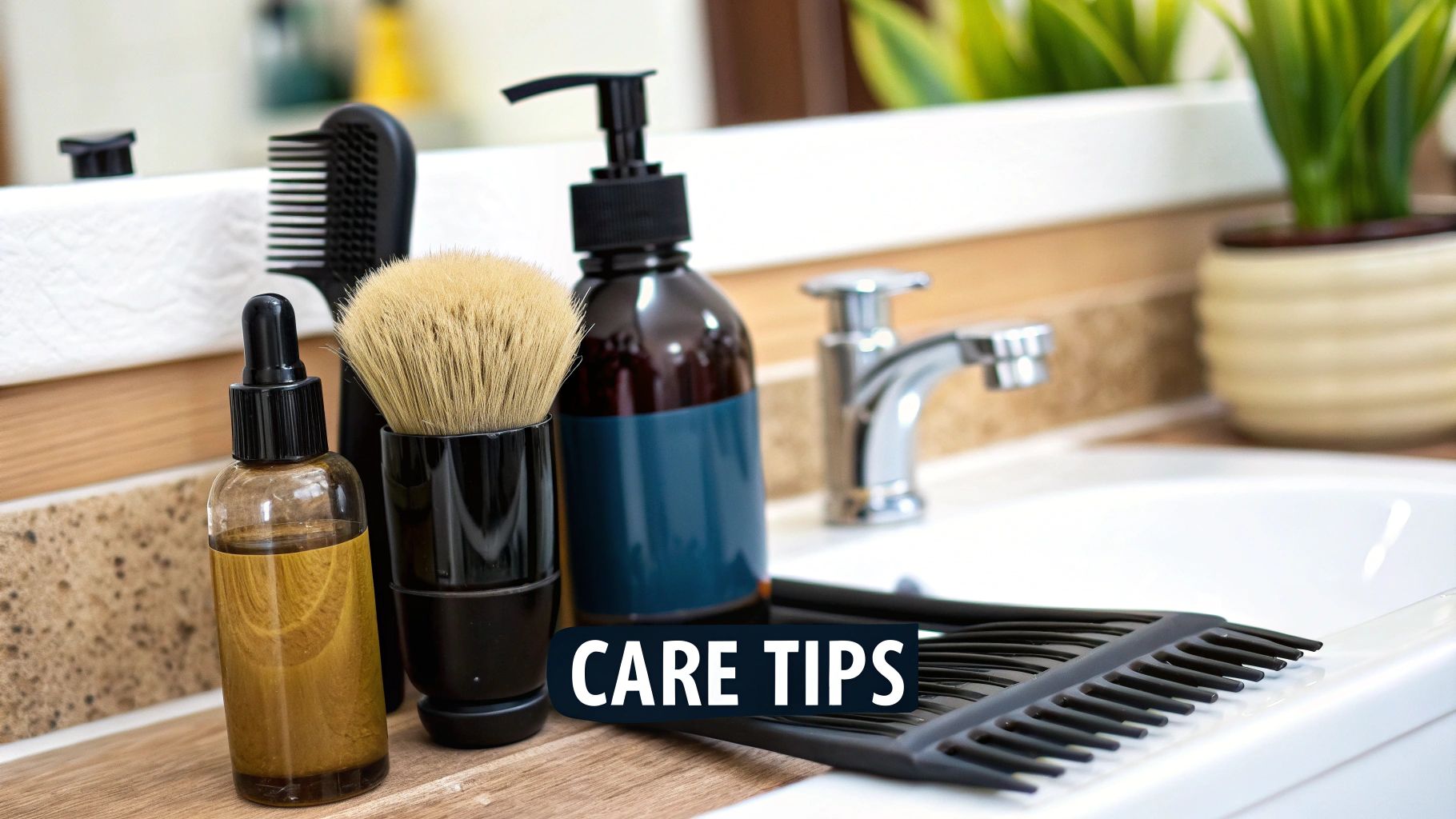
A good aftercare plan isn't just about the extensions, either. It’s about keeping your own hair healthy, vibrant, and tangle-free underneath it all. Tiny tweaks to how you wash, brush, and even sleep can make a massive difference, preventing damage to the bonds and keeping the hair itself silky smooth.
Your Daily and Weekly Hair Care Ritual
Getting into a gentle hair care groove is probably the single most important part of living with extensions. It’s not hard, but it does require a bit of conscious effort. Being too rough is the quickest way to cause tangles, matting, or stress at the attachment points, so a light touch is your new best friend.
First things first: use only the sulfate-free shampoo and conditioner your stylist recommends. When you wash, don’t flip your hair upside down. Instead, tilt your head back and let the water flow downwards. Lather the shampoo at your scalp with your fingertips, but never scrub aggressively at the bonds or wefts.
Essential Brushing and Washing Tips:
- Get the Right Brush: You absolutely need a special extension brush. They have soft, looped bristles designed to glide right over the bonds without catching or pulling.
- Brush Smart: Hold the base of your hair (where the extensions are attached) with one hand and gently brush from the ends up. This supports the bond and prevents any tension on your scalp.
- Condition Carefully: Conditioner is for your hair, not your bonds. Apply it only from the mid-lengths down to the ends. If it gets on the bonds, it can cause them to become slippery and loose over time.
One of the most effective—and most often forgotten—aftercare steps is protecting your hair while you sleep. All that tossing and turning on a cotton pillowcase creates friction, leading to a tangled, frizzy mess in the morning.
The fix is surprisingly simple. Before bed, loosely braid your hair or pull it into a low ponytail. This one small step stops it from tangling overnight. Even better? Swap your cotton pillowcase for a silk or satin one. The slippery surface means less friction, which helps both your extensions and your natural hair stay smooth and hydrated. Trust me, this little change is a total game-changer for keeping that just-left-the-salon look.
When you're searching for "hair extension services near me," make sure to ask the stylist about their specific aftercare advice. A great professional will make sure you walk out the door completely prepared.
Answering Your Top Questions About Hair Extensions
Thinking about professional extensions for the first time? It's completely normal to have a ton of questions. This is a real investment in yourself and how you feel, so you want to be sure about every detail before you jump in.
We've put together the most common questions we hear from clients who walk through our doors. Our goal is to give you clear, honest answers so you can move forward feeling confident and excited, not uncertain.
How Much Do Hair Extension Services Cost?
This is usually the first question on everyone's mind, and the honest answer is: it depends. The final price of extensions isn't a one-size-fits-all number; it’s a custom quote based on your unique hair and the look you want to achieve.
Think of it as two parts: the cost of the hair itself and the cost of the stylist's expertise and time. The more length or volume you want, the more hair you'll need. Likewise, a meticulous, hours-long application is going to be priced differently than a quicker method.
Here's what goes into building your final price:
- Hair Quality: We exclusively use 100% Remy human hair. It's the gold standard for a reason—it looks natural, lasts longer, and styles beautifully.
- Amount of Hair: Adding a few pieces for a little pop of volume is a very different service than adding 12 inches of new length, which requires significantly more hair.
- Application Method: A detailed, strand-by-strand fusion application is an art form that takes time. A tape-in service, while still requiring skill, is a much faster process. The time commitment is a big factor in the cost.
- Stylist's Expertise: You're not just paying for hair; you're paying for the skill, training, and experience of a certified extension specialist who knows how to protect your natural hair.
The only way to get a solid number is through a personalized consultation. That's where a stylist can actually see your hair, listen to your goals, and map out a plan built just for you.
Will Hair Extensions Damage My Natural Hair?
This is probably the biggest fear we hear, and it’s a fair one! The short answer is no, professionally installed hair extensions will not damage your natural hair. The key here is the "professional" part.
When damage does happen, it almost always comes down to two culprits: improper application by an untrained person or poor aftercare at home. If someone puts the bonds on too tightly or uses the wrong technique for your hair type, it can cause stress on your roots. On your end, if you don't brush them correctly or use products that weaken the bonds, you can run into trouble with tangling.
Think of a professional application as your insurance policy for healthy hair. A trained stylist’s top priority is the integrity of your own hair. They know exactly how to place each extension with the right tension and weight distribution to keep your hair safe and strong.
In fact, many people use extensions to feel more confident while dealing with thinning hair. For a deeper dive into that subject, this guide on what causes hair loss in women offers some great insights.
How Long Does the Application Process Take?
The time you'll spend in the salon really comes down to which type of extension you choose. Some methods are quick and get you out the door in no time, while others are a more detailed and luxurious experience.
For instance, tape-in extensions are famous for their speed. A full application can often be done in just 1 to 2 hours. It's a fantastic option if you have a packed schedule.
On the other hand, methods like fusion bonds or micro-links are much more intricate. These require placing each strand individually, so a full head can take anywhere from 3 to 5 hours. Knowing this upfront helps you plan your day and settle in for the process.
Can I Style My Extensions Like Normal Hair?
Yes, absolutely! This is one of the best parts about getting high-quality human hair extensions. You can curl them, straighten them, and wear them up or down just like you would with your own hair.
There are just a couple of ground rules to keep them looking amazing. First, always use a heat protectant spray before picking up a hot tool—this is non-negotiable! And second, be careful to avoid applying direct heat right on the bonds, tapes, or beads. High heat can melt or weaken the adhesive, causing the extensions to slip.
With just a little care, you can style them endlessly. The ability to instantly transform a look is a huge reason why the hair extension market is booming. What was once an USD 8.9 billion industry is now projected to hit USD 20.1 billion, largely thanks to social media showcasing just how versatile great hair can be.
